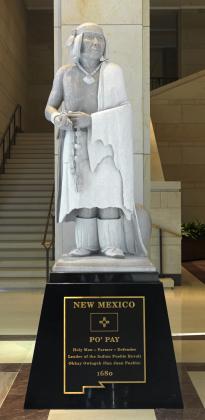 |
| We are so diverse, we all have different ways of asking for a "coke", or a "soda", or a "pop", or a ... you get the point. |
The Indian Pueblo Revolt of 1680 was the first successful American revolution and was only made possible by the tradition of running. As a result of oppression by Spanish land owners relying on Pueblo laborers and religious oppression of Native American practices by Franciscan missionaries, Pueblo leaders gathered at Red Willow (Taos Pueblo) to organize a revolt.
 |
| North pueblo at Taos (The North American Indian; v.16) CREATOR Curtis, Edward S., 1868-1952. |
Po'pay, known as the leader of this revolt, organized pueblos as far west as Hopi (300 miles from Taos) and as far south as Isleta (150 miles from Taos) using runners. Each runner was sent with yucca cords containing an equal number of knots. Each day a knot on the cord would be untied signifying a countdown of when each pueblo was to grab hidden weapons and "burn the temples, break up the bells." As a result of the overwhelming numbers from the pueblos, the Spanish were successfully forced out of the region and the pueblos lived without the Spanish for 12 years following.
In 1692, Diego de Vargas entered the region and reestablished a series of Spanish settlements, while the Franciscans once again implemented missions in Pueblo villages. Significant concessions by the Spanish had to be made in order for these settlements to remain successful. As a direct result of the organization led by Po'pay and facilitated by the runners, many modern Pueblo peoples credit the Pueblo Revolt with preserving their Native beliefs and cultural ways as they continue to exist even today.
 |
| Mission San Esteban Rey was built c.1641, photograph by Ansel Adams, c.1941 |
As an example, Acoma (just a few miles west of Albuquerque) people constructed a Spanish church in 1641, the church survived the rebellion and it remains in use, but a short walk takes visitors past ladders that lead to the rooftop entrances of kivas, where the old ways also endure.
 |
Statue of Po’pay given by New Mexico for display in the National Statuary Hall Collection.
|
In summary, the beauty of our uniqueness is due to the efforts of a running tradition that is deeply rooted within our New Mexican culture. My profound respect for the Native American culture comes from it's ability to maintain it's cultural traditions over centuries of adversity. As a local, I am happy to say that running is not only apart of my lifestyle but in my blood.
For those of you running in the Albuquerque foothills, I encourage you to use your imaginations and take yourselves back to 1680. Try to put yourselves in the feet of a Pueblo messenger, imagine your purpose is to pass on a message, a message meant to preserve a culture. Happy training!
Encouraged reading on this subject:
Harvard University has a great online exhibit expressing the deep tradition of running amongst American Indians, including a list of Olympians and marathon records set by American Indians.

No comments:
Post a Comment